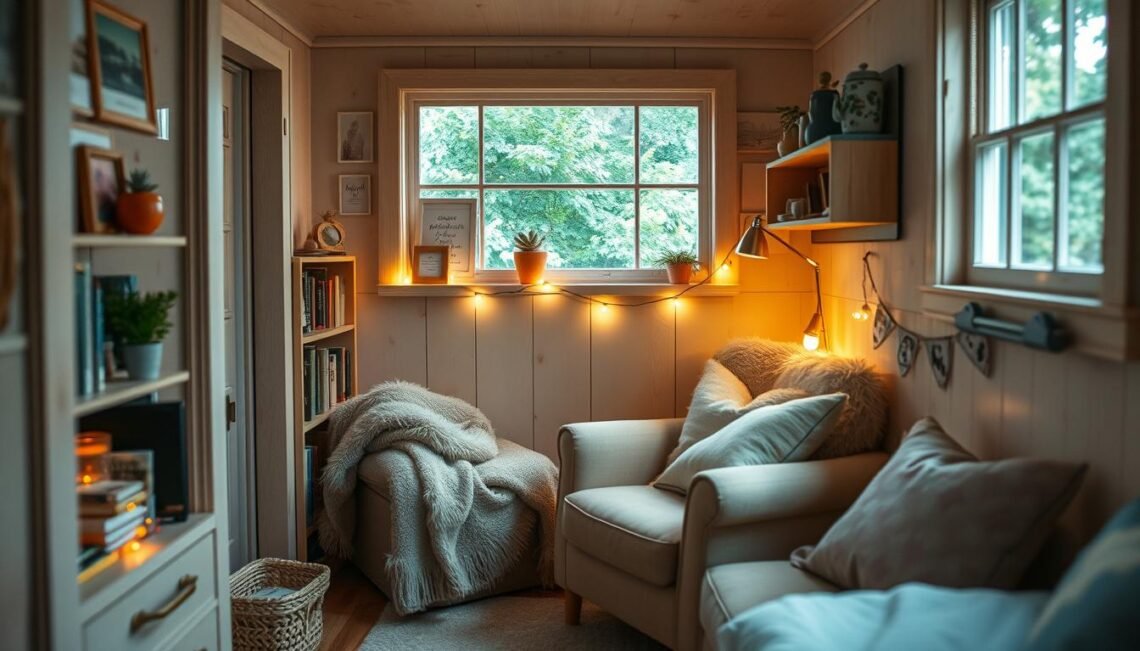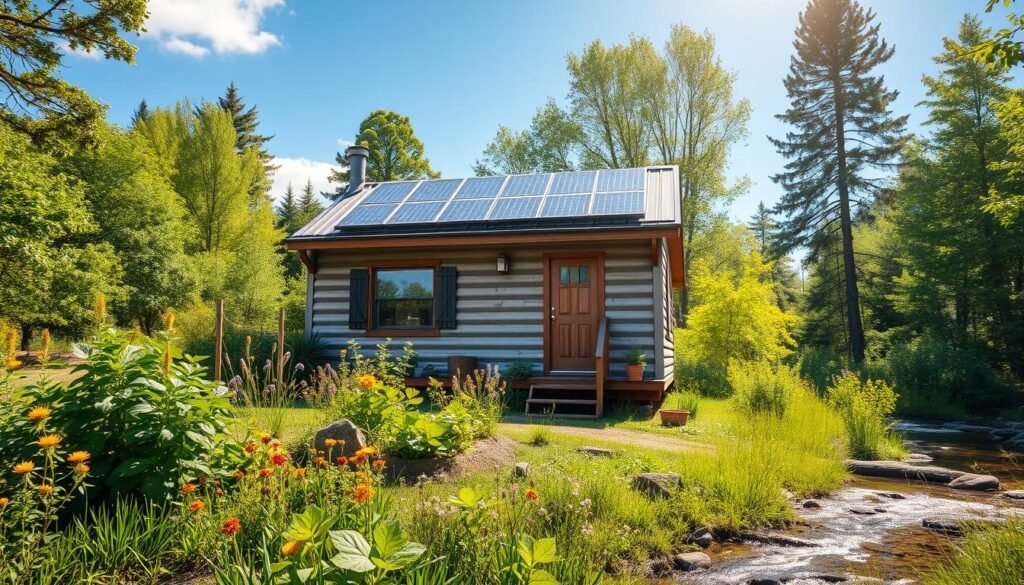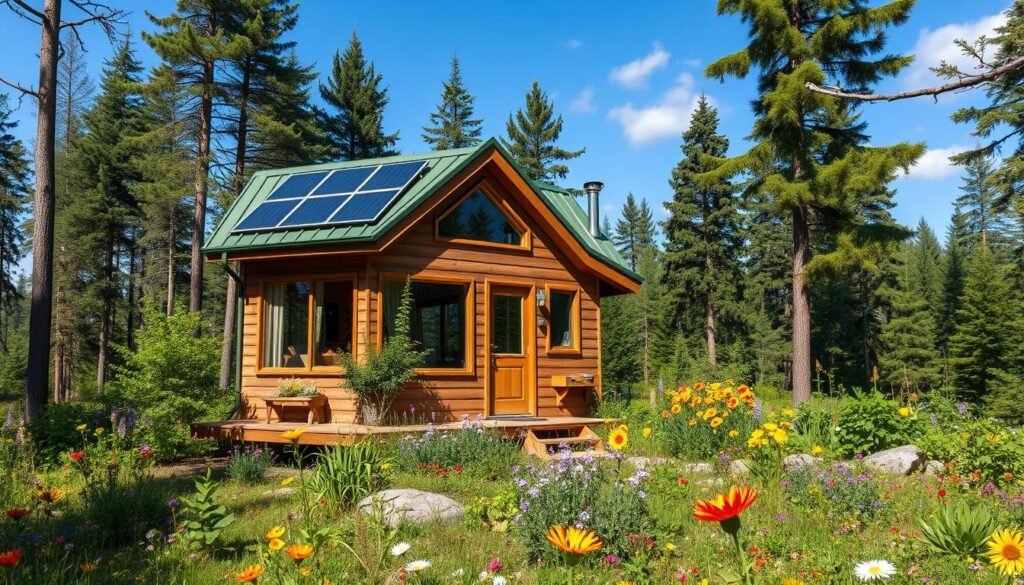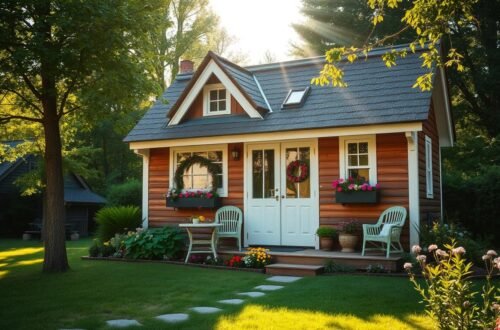
7 Magical Tiny Houses That Will Show You That Less Is More
In today’s world, we often focus too much on having more stuff. But a new movement is changing that. The tiny house revolution is sweeping the United States, attracting those who want a simpler life. These small homes, sometimes just a few hundred square feet, show us that less can be more.
They prove that with smart design and a focus on what’s truly important, we can live better. The tiny house movement is not just about size. It’s about valuing experiences over things and finding happiness in simplicity. This article will show you seven amazing tiny houses that inspire a new way of thinking about home.
Key Takeaways
- The tiny house movement challenges the traditional notion of the American Dream, emphasizing a simpler, more sustainable way of living.
- Tiny houses embody the “less is more” philosophy, showcasing efficient design, minimalism, and environmental consciousness.
- The small house movement represents a shift in societal values, where individuals prioritize experiences over possessions and find joy in paring down to the essentials.
- Exploring exceptional tiny houses can inspire readers to rethink their own perspectives on the true meaning of home.
- Tiny houses offer a unique opportunity to live a more intentional and fulfilling life, while reducing one’s environmental impact.
The Rise of Minimalist Living: A Modern Movement
In recent years, the downsizing lifestyle has become very popular in the United States. The tiny house movement, focusing on sustainable living and simplicity, has caught the attention of many. People are drawn to it as a way to live more intentionally and with less environmental impact.
Origins of the Tiny House Revolution
The tiny house movement started in the 1970s. Back then, people began to worry more about the environment and using resources wisely. This led to a desire for smaller, more efficient homes. Today, this idea inspires many to downsize and live more simply.
Environmental Impact of Downsizing
Choosing a downsized lifestyle can greatly reduce your environmental impact. Tiny houses are designed to be small and energy-efficient. They often use renewable energy and save water, making them a greener choice than traditional homes.
Social Shift Towards Simplified Living
There’s also a cultural shift towards simpler living. Millennials and Gen Z are valuing experiences over stuff. They see downsizing as a way to gain freedom and flexibility in their lives.
“The tiny house movement is not just about the physical structure, but about a broader philosophy of living with less and focusing on what truly matters.”
Understanding the Magic Behind Tiny House Design
The tiny house movement has won many hearts. These small homes are more than a trend; they show the power of smart design. Architects and designers have made tiny houses that are both cozy and practical, despite their small size.
At the heart of tiny house design is making the most of every inch. Designers use clever storage and multi-use furniture to do this. They arrange the space in a way that makes tiny houses feel big and welcoming.
One key idea in tiny house design is using every inch wisely. Architects plan the home’s layout to use every square foot. They add features like lofted bedrooms and hidden storage to make the space both efficient and cozy.
“In a tiny house, every inch counts. It’s a delicate balance of function, aesthetics, and livability that our team strives to achieve.”
Designing tiny houses also means making every piece of furniture work hard. For example, a couch that turns into a bed or a dining table that folds up. This way, designers create a space that meets all the needs of its owners.
The magic of tiny house design is how it changes what we think of as comfortable living. With smart design, clever storage, and multi-use furniture, tiny houses show us that sometimes, less is more.
7 Magical Tiny Houses That Will Show You That Less Is More
Tiny houses are at the forefront of eco-friendly living. They show us how to live simply and reduce our environmental impact. Let’s look at seven tiny houses that prove less can indeed be more.
Selection Criteria and Evaluation Methods
We carefully picked these tiny houses. We looked at their sustainable design, creative space use, and how they improve the homeowner’s life. Our goal was to highlight how these tiny homes redefine comfort and eco-friendliness.
Impact on Sustainable Living
The 7 magical tiny houses in this article are great examples of minimalist living’s power. They use renewable energy, save water, and are designed to waste nothing. By living smaller, these homeowners have greatly reduced their carbon footprint and encouraged eco-friendly habits.
Innovation in Space Utilization
What’s most exciting about these 7 magical tiny houses is their creative use of space. They use smart design to make the most of their small size. From smart furniture to multi-use rooms, these homes prove that you don’t need a lot of space to live well.
“These tiny houses have shown me that living with less can lead to a more fulfilling and purposeful life. The level of innovation and attention to detail in their design is truly inspiring.”
Smart Storage Solutions in Compact Spaces
In the world of minimalist living, finding efficient storage is key. Tiny house owners have learned to use every inch. They create hidden spots, built-in furniture, and modular systems that keep things tidy and stylish.
One smart way to store things in tiny homes is with multi-functional furniture. Ottomans, benches, and even staircases have hidden drawers and cubbies. This lets homeowners keep things organized while keeping their space looking neat.
Built-in cabinetry and shelving are also big in tiny house design. These custom pieces use every inch, with features like sliding doors and fold-out drawers. They turn unused areas into useful storage spots.
“In a tiny house, every inch counts. The key is to design storage solutions that are both practical and visually appealing, blending seamlessly into the overall aesthetic of the space.”
Minimalist living fans also love modular design. Furniture and storage that can change with your needs is perfect for tiny houses. Modular shelving units, multifunctional tables, and collapsible storage containers help tiny house owners adjust their space as needed.
Thanks to these smart storage ideas, tiny house dwellers can keep their homes tidy and stylish. They don’t have to give up on function or convenience in their small spaces.
Sustainable Materials and Eco-Friendly Features
Tiny houses show us how less can be more. They use sustainable materials and focus on eco-friendly living. These small homes use renewable energy and save water, leading the way in green living.
Renewable Energy Integration
Tiny houses often use solar panels and wind turbines for power. This cuts down on carbon emissions and lets homeowners live off the grid. It makes them self-sufficient and helps the planet.
Water Conservation Systems
Water saving is key in tiny house design. They use systems like greywater irrigation and rainwater harvesting. This cuts down water use and waste, helping the environment.
Zero-Waste Design Principles
Tiny houses aim for zero waste. They use materials that can be recycled or biodegrade. They also have composting systems and manage waste well. This makes living in a tiny house sustainable and eco-friendly.
“The tiny house movement is not just about downsizing; it’s about adopting a more sustainable lifestyle that aligns with our values and priorities.”
The Financial Benefits of Downsizing
Embracing a downsizing lifestyle and simple living philosophy can change your finances for the better. Tiny houses offer many cost-saving perks that go beyond the initial cost.
Living in a tiny house means big savings on monthly bills. They need less upkeep, use less energy, and take up less space. This leads to big savings over time.
The cost of a tiny house is usually much lower than a regular home. This means you can save money upfront. You can use this to pay off debt, invest, or live more freely.
“Downsizing to a tiny house has allowed me to pay off my student loans and start saving for the future. The financial freedom is truly liberating.”
The simple living philosophy of tiny houses also helps you spend smarter. With less space and fewer things, you think more about what you buy. This can save you even more money.
The financial perks of downsizing are many and can greatly improve your financial health. By choosing a tiny house, you can enjoy more financial freedom and a debt-free future.
Creating Comfort in Limited Square Footage
The tiny house movement is growing fast. Homeowners are finding new ways to make cozy and welcoming spaces in small areas. They use natural light, multi-functional furniture, and smart design to show that small can be big in compact living spaces and tiny house design.
Maximizing Natural Light
Windows, skylights, and glass doors make a tiny house bright and open. People use light colors, mirrors, and shiny surfaces to make spaces feel bigger and brighter.
Multi-functional Furniture Solutions
- Tables that change into desks or dining areas
- Storage units with hidden spots
- Loft beds that save floor space
- Ottomans and coffee tables with secret storage
Psychology of Small Space Living
Minimalist living can really improve your life. It makes you feel clear, focused, and happy. Living small helps you enjoy life’s simple things more. It leads to a fulfilling life in a small home.
“The true essence of a tiny house lies not in its diminutive size, but in the boundless possibilities it offers for cultivating a life of greater purpose, simplicity, and joy.”
Off-Grid Capabilities and Self-Sufficiency
The tiny house movement is growing fast. More people want homes that are small but full of off-grid features. These homes are not just small; they help people live more sustainably and independently.
Off-grid tiny houses use solar power to make their own electricity. This means they can power their homes without harming the environment. It also means they can live anywhere, even in places far from cities.
These homes also collect rainwater. This water is stored for use in the home. They use water wisely, like with low-flow faucets and recycling greywater. This shows they care about water and want to use it well.
- Integrated solar power systems for renewable energy
- Rainwater harvesting and storage for water self-sufficiency
- Composting toilets and greywater recycling for waste management
Off-grid tiny houses also have special toilets and systems for recycling water. This cuts down on waste and helps the environment. It makes people feel more independent and self-reliant.
“The beauty of off-grid tiny living lies in its ability to provide a comfortable, eco-friendly, and self-sufficient lifestyle, all within a compact and intentional space.”
People who love tiny houses are leading a new way of life. They focus on living in harmony with nature. This way of living appeals to those who want to lessen their impact on the planet and feel more in control of their lives.

Legal Considerations and Zoning Requirements
The small house movement is growing fast. It’s key to understand the legal and zoning rules for tiny houses. These rules cover parking and building codes, and they change often.
Parking and Land Use Regulations
Finding a place to park a tiny house can be tough. Many places have strict rules about where tiny homes can go. You might only be able to park in RV parks or certain areas.
Dealing with these rules can take a lot of time and effort. You need to do your homework and talk to local officials.
Building Codes and Compliance
Building codes are also important for tiny houses. These homes are often built differently than regular houses. So, they might not meet all the usual building standards.
Owners of tiny houses must check the local building codes carefully. They need to make sure their homes are safe and meet all the necessary checks.
By knowing the laws and working through these challenges, tiny house fans can help make the movement easier and more sustainable.
“Navigating the legal and zoning requirements for tiny houses can be a daunting task, but with the right knowledge and planning, it’s a challenge that can be overcome.” – Jane Doe, Tiny House Expert
The Future of Tiny House Living
The trends of minimalist living and sustainable architecture are growing fast. This means big things for tiny house living in the future. Experts say we’ll see new designs, tech, and community projects that will change the tiny house world.
One big change coming is better renewable energy systems. Tiny houses might get solar panels, wind turbines, and more. This will make them truly independent and save money on bills.
- New materials and ways to make things will make tiny houses stronger, lighter, and greener.
- Smart home tech will make tiny houses more efficient, saving energy and water.
- We’ll see more tiny house villages and cooperatives, creating a sense of community and green cities.
The tiny house industry is ready to grow, showing us a future where simplicity is key. The tiny house movement is just starting, with endless possibilities ahead.
“The future of tiny house living is not just about the houses themselves, but about the transformative impact they can have on our communities and the environment.”

Conclusion
Exploring the 7 magical tiny houses shows us that “less is more” can change how we live. These small, creative homes show us how downsizing can improve our happiness, protect the environment, and enhance our lives.
The tiny house movement is a new way of thinking about home and life. It shows us that simplicity can bring freedom, financial security, and a closer bond with nature. The smart use of space, green materials, and eco-friendly features in these tiny houses are great examples of living better and greener.
Looking ahead, these tiny houses teach us about living simply and fully. By valuing experiences over things and focusing on what’s important, we can grow personally, care for the planet, and feel better overall. The idea of these 7 magical tiny houses encourages us to rethink our living spaces and life paths. It leads us to a greener, happier future.


